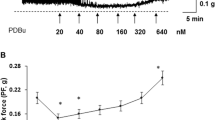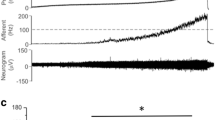Summary
12-O-tetradecanoylphorbol-13-acetate (TPA) is known to affect the proliferation and/or differentiation of several types of cells. We injected TPA directly into the lumen of rat bladder to determine, using scanning and transmission electron microscopy, its effects on the bladder epithelium in vivo. At 1 h after TPA injection (1μg/ml), the superficial cells of the epithelium had changed their morphology, and large spherical vacuoles occupied their cytoplasm. In some areas, the underlying intermediate cells were exposed by the desquamation of the superficial cells. During the next few hours, TPA was excreted from the bladder lumen by voluntary micturition, but the desquamation of the superficial cells proceeded further. All the superficial cells were lost from the luminal surface by 24 h after TPA injection. The changes noted were specific for the superficial cells and were not observed in the intermediate or basal cells. After 24h, part of the epithelium had a three-layer structure, indicating that regeneration was taking place. These results demonstrate that TPA selectively affects and desquamates superficial cells in a short period of time. This experimental system may be useful for studying in vivo cell proliferation and/or differentiation.
Similar content being viewed by others
References
Ben-Ze'ev A (1986) Tumor promoter-induced disruption of junctional complexes in cultured epithelial cells is followed by the inhibition of cytokeratin and desmoplakin synthesis. Exp Cell Res 210:335–352
Cohen SM, Arai M, Jacobs JB, Friedell GH (1979) Promoting effect of saccharin and DL-tryptophan in urinary bladder carcinogenesis. Cancer Res 39:1207–1217
Cooper EH (1972) The biology of bladder cancer. Ann R Coll Surg Engl 51:1–16
Erturk E, Price JM, Morris JE, Cohen S, Leith RS, Von Esch AM, Crovetti AJ (1967) The production of carcinoma of the urinary bladder in rats by feeding N-4-(5-nitro-2-furyl)-2-thiazolyl formamide. Cancer Res 27:1998–2002
Fukushima S, Friedell GH, Jacobs JB, Cohen SM (1981) Effects of L-tryptophan and sodium saccharin on urinary bladder carcinogenesis initiated by N-[4-(5-nitro-2-furyl)-2-thiazolyl]formamide. Cancer Res 41:3100–3103
Grant NJ, Aunis D (1990) Effects of phorbol esters on cytoskeletal proteins in cultured bovine chromaffin cells: induction of neurofilament phosphorylation and reorganization of actin. Eur J Cell Biol 52:36–46
Hicks RM, Chowaniec C (1977) The importance of synergy in the induction of bladder cancer in experimental animals and humans. Cancer Res 37:2943–2949
Hicks RM, Wakefield JSJ (1972) Rapid induction of bladder cancer in rats with N-methyl-N-nitrosurea. I. Histology. Chem Biol Interact 5:139–152
Inagaki M, Nishi Y, Nishizawa K, Matsuyama M, Sato C (1987) Site-specific phosphorylation induces disassembly of vimentin filaments in vitro. Nature 328:649–652
Inagaki M, Gonda Y, Matsuyama M, Nishizawa K, Nishi Y, Sato C (1988) Intermediate filament reconstitution in vitro. The role of phosphorylation on the assembly-disassembly of desmin. J Biol Chem 263:5970–5978
Ito N, Hiasa Y, Tamai A, Okajima E, Kitamura H (1969) Histogenesis of urinary bladder tumors induced by N-butyl-N-(4-hydroxybutyl)nitrosamine in rats. Jpn J Cancer Res (Gann) 60:401–410
Izumi K, Hirao Y, Hopp L, Oyasu R (1981) In vitro induction of ornithine decarboxylase in urinary bladder carcinoma cells. Cancer Res 41:405–409
Izumi K, Shibata M, Togei K, Akagi A, Otsuka H, Jacobs JB, Ozono S, Miyata Y, Oyasu R (1984) Effects of 12-O-tetradecan-oylphorbol-13-acetate on carcinogenesis in the heterotopically transplanted rat urinary bladder. Jpn J Cancer Res (Gann) 75:756–762
Jaken S, Leach K, Klauck T (1989) Association of type 3 protein kinase C with focal contacts in rat embryo fibroblasts. J Cell Biol 109:697–704
Katoh N, Wise BC, Fuo JF (1983) Phosphorylation of cardiac troponin inhibitory subunit (troponin I) and tropomyosin-binding subunits (troponin T) by cardiac phospholipid-sensitive, Ca2+-dependent protein kinase. Biochem J 209:189–195
Kawamoto S, Hidaka H (1984) Ca2+-activated, phospholipid-dependent protein kinase catalyzes the phosphorylation of actinbinding proteins. Biochem Biophys Res Commun 118:736–742
Kikkawa U, Takai Y, Minakuchi R, Inohara S, Nishizuka Y (1983) Protein kinase C as a possible receptor protein of tumor-promoting phorbol esters. J Biol Chem 258:11442–11445
Levi PE, Cowan DM, Cooper E (1969) Induction of cell proliferation in the mouse bladder by 4-ethylsulphonyl-naphthalen-1-sulphonamide. Cell Tissue Kinet 2:249–262
Litchfield DW, Ball EH (1986) Phosphorylation of the cytoskeletal protein talin by protein kinase C. Biochem Biophys Res Commun 134:1276–1280
Locher GW, Cooper EH (1970) Repair of rat urinary bladder epithelium following injury by cyclophosphamide. Invest Urol 8:116–123
Martin BF (1972) Cell replacement and differentiation in transitional epithelium; a histological and autoradiographic study on the guinea pig bladder and ureter. J Anat 112:433–455
Messing EM, Hanson P, Ulrich P, Erturk E (1987) Epidermal growth factor-interactions with normal and malignant urothelium: in vivo and in situ studies. J Urol 138:1329–1335
Naka MM, Nishikawa RS, Adelstein RS, Hidaka H (1983) Phorbol ester-induced activation of human platelets is associated with protein kinase C phosphorylation of myosin light chains. Nature 306:490–492
Nelson KG, Slaga TJ (1982) Keratin modifications in epidermis, palillomas, and carcinomas during two-step carcinogenesis in the SENCAR mouse. Cancer Res 42:4176–4181
Nelson KG, Stephenson KB, Slaga TJ (1982) Protein modifications induced in mouse epidermis by potent and weak tumor-promoting hyperplasiogenic agents. Cancer Res 42:4164–4175
Ojakian GK (1981) Tumor promoter-induced changes in the permeability of epithelial cell tight junctions. Cell 23:95–103
Pamukcu AM, Erturk E, Yalciner S, Bryan GT (1976) Histogenesis of urinary bladder cancer induced in rats by bracken fern. Invest Urol 14:213–218
Rink TJ, Sanchez A, Hallam TJ (1983) Diacylglycerol and phorbol ester stimulate secretion without raising cytoplasmic free calcium in human platelets. Nature 305:317–319
Schweizer J, Winter H (1982) Changes in regional keratin polypeptide patterns during phorbol ester-mediated reversible and permanently sustained hyperplasia of mouse epidermis. Cancer Res 42:1517–1529
Skouv J, Christensen B, Skibshj I, Autrup H (1986) The skin tumorpromoter 12-O-tetradecanoylphorbol-13-acetate induces transcription of the c-fos proto-oncogene in human bladder epithelial cells. Carcinogenesis 7:331–333
Toftgard R, Yuspas SH, Roop DR (1985) Keratin gene expression in mouse skin tumors and in mouse skin treated with 12-O-tetradecanoylphorbol-13-acetate. Cancer Res 45:5845–5850
Vandenbark GR, Niedel JE (1984) Phorbol diesters and cellular differentiation. J Natl Cancer Inst 73:1013–1019
Verma AK, Erturk E, Bryan GT (1983) Specific binding, stimulation of rodent urinary bladder epithelial ornithine decarboxylase, and induction of transitional cell hyperplasia by the skin tumor promoter 12-O-tetradecanoylphorbol-13-acetate. Cancer Res 43:5964–5971
Watanabe S, Sasaki J (1988) Cytoskeletal architecture in the transitional epithelial cells of a rat urinary bladder as demonstrated by detergent perfusion. J Electron Microsc 37:305–314
Watanabe S, Sasaki J, Kouno T, Okada T, Otsuka N (1991) Immunofluorescence microscopic study on the cytoskeletal filaments in the separated superficial cells of rat urinary bladder epithelium. Acta Histochem Cytochem 24:21–27
Werth DK, Niedel JE, Pastan I (1983) Vinculin, a cytoskeletal substrate of protein kinase C. J Biol Chem 258:11423–11426
Author information
Authors and Affiliations
Rights and permissions
About this article
Cite this article
Watanabe, S., Sasaki, J. 12-O-tetradecanoylphorbol-13-acetate induces selective desquamation of superficial cells in rat urinary bladder epithelium. Cell Tissue Res 268, 239–245 (1992). https://doi.org/10.1007/BF00318792
Received:
Accepted:
Issue Date:
DOI: https://doi.org/10.1007/BF00318792




